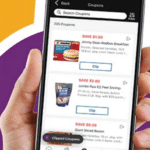
It started as a consumer group’s call to action in support of shoppers unable to take advantage of digital-only discounts. Now, you could say it’s becoming a movement, as a bill requiring offline alternatives to digital-only deals is one step closer to becoming law in one state, while another state has jumped on the bandwagon by becoming the third so far to consider legislation of its own.
The New Jersey Assembly’s Consumer Affairs Committee has advanced a bill that would require businesses in the state offering digital discounts to make available an “in-store alternative of identical value” for the benefit of those who are not digitally-engaged.
That phrasing represents a small but notable change from the original version of the bill, introduced by Democratic New Jersey Assemblyman and Consumer Affairs Committee chair Paul Moriarty back in January. That version would have mandated “a paper coupon of identical value.” Now, it more broadly calls for an “in-store alternative… including, but not limited to, paper coupons, electronic kiosks, or application of the discounted price or benefit at the point-of-sale upon the request of the consumer.”
Several stakeholders testified both for and against the proposal at Monday’s hearing. Many groups representing businesses in the state expressed their opposition. It’s “just another burden on businesses,” Eileen Kean, New Jersey state director of the National Federation of Independent Business, told the panel. “Let’s let businesses figure out what works best for them. Let’s try to stop this overreach.”
Others expressed concern about the impact on smaller retailers that may not be equipped to easily offer an in-store alternative, or the impact on digital manufacturer’s coupons, over which retailers have no control and no ability to offer in alternate formats. “We certainly don’t want our manufacturers to feel that they can no longer offer coupons to their retailers in New Jersey,” Mary Ellen Peppard, Vice President of the New Jersey Food Council, testified. Besides, digital coupons are good for consumers, she argued. “There’s a lot less cost to digital coupons, they are not as labor-intensive, and they’re not as prone to fraud. And so those savings can be passed on to the customers.”
“I think manufacturers should want to feel that they don’t want to be discriminatory towards large segments of our population when it comes to offering discounts,” Moriarty countered.
Nearly a year ago, consumer advocate Edgar Dworsky, founder and editor of Consumer World, reviewed dozens of grocery circulars, and found that two-thirds featured some form of digital-only discounts. The “sale price” was prominently advertised, but you had to load a digital coupon, or activate a loyalty discount online, in order to get the deal. And many seniors, lower-income shoppers and others without easy access to the internet would be left out and have to pay full price. Dworsky later joined forces with other consumer groups in sending a letter to a dozen large supermarket chains urging them to consider changes.
In his own testimony to the New Jersey committee, Chuck Bell, Programs Director for Consumer Reports, called out retailers that are “advertising discounts prominently on the covers of all these circulars, and 20-25% of the public can’t get access to those discounts. So it looks like you’re offering a lower price… but it’s actually not obtainable by many of your customers.” Instead, it’s a “bait and switch,” he alleged. Old-fashioned paper coupon clipping, in contrast, “was something that everyone could participate in at every income level. You didn’t need expensive technology to be able to do that.” But now you do, as paper coupons fall out of favor and more discounts are going digital.
“What are we doing?” asked Assemblywoman Annette Quijano, Democratic vice chair of the committee. “We’re rushing towards technology but we’re forgetting poor people, and individuals that do not have a computer, or don’t have the wherewithal to know how to use a computer.”
Richard Rebh, CEO of retail marketing firm EntryPoint Communications, explained how his company provides in-store kiosks that shoppers can access to download deals – including digital manufacturer’s coupons – even if they don’t have a smartphone or a computer at home to load coupons and discounts before they shop.
See, Moriarty pointed out to skeptics, “there are solutions out there. This is not the end of the world, and this legislation is not the craziest thing out there.”
Assemblyman Nader Sayegh in the neighboring state of New York would seem to agree. On the same day that New Jersey lawmakers were debating their digital-discount bill, Sayegh introduced his own version in New York. “A person selling or offering for sale goods or services at retail that offers a digital coupon shall make available to a consumer a paper coupon of identical value,” his bill reads, in language identical to that originally proposed by Moriarty in New Jersey. Sayegh’s office did not immediately respond to a request for comment, about whether he had been in communication with Moriarty, or was merely inspired by his bill.
Either way, New York now becomes the third state to propose such legislation this year, after an Illinois lawmaker did the same a few months ago.
“I am gratified that the bill in the New Jersey legislature has inspired other states to take a stand against digital discrimination,” Consumer World’s Dworsky told Coupons in the News. “Too many seniors and other unplugged shoppers are forced to pay higher grocery prices than necessary, particularly during this wave of record-high inflation, simply because they cannot access digital coupons.”
“There have to be some guardrails to help assure that there is reasonable access to discounts for all shoppers,” Consumer Reports’ Bell told the New Jersey committee. Rebh of EntryPoint Communications agreed. Retailers “have made a decision, without necessarily publicizing it, that the older people, the people who are not digital – that is the past, and we are going to quietly walk away from that,” he said. “So I think it’s reasonable to put a requirement on them that they address this issue, when their reason for not addressing it is profit motive.”
The committee voted to advance the bill to the larger Commerce and Economic Development Committee, which could ultimately put it to the full Assembly for a vote.
While he said he’s sympathetic to retailers and manufacturers that would have to work out ways to comply should the bill become law, “we are the consumer committee, so that’s all I think about, is consumers,” Moriarty said – before adding pointedly, to the committee room full of retail industry representatives, that consumers “don’t have any lobbyists.”
But digitally-disconnected consumers do have at least a few lawmakers on their side. Whether those lawmakers can get enough of their colleagues to support their efforts, could determine whether this grassroots movement aimed at slowing the digital transformation of grocery discounts might ultimately blossom into the law of the land.











Digital coupons are a HIGHT barrier to access. Not everyone can get to a public library during their hours of operation or the distances to travel. That is a non sequitur. In my city, some of the closest public libraries are closed for remodeling. It would still take two buses to get to any of them. They are not open 24/7. To obtain one or two digital coupons a person must take at least two buses and find an open public library? Sounds callous to me. Sounds very ageist, ableist, elitist and classist. It is an exclusionary and discriminatory practice.
This is digital redlining. Discrimination against certain demographics. Not everyone can afford or has stable wifi service at home. There is an income limit to get subsidized Internet access. If a person is over that income threshold even by a $100 they are not qualified.
My neighbor cannot afford Internet service. She also has a bad case of macular and no longer owns a computer. She does not own a cell phone (cannot afford it) Cell phones may be inexpensive but the monthly plans are not. In some areas the coverage is very spotty.
My sister on the other hand has a computer but half the time her Internet is very, very unstable. For her to load a single page on Fred Meyer’s site, takes at least 10 minutes. With a paper coupon, one would have already read all the ads and clipped the coupons that pertain in the same amount of time one page is loading on a very slow wifi connection.
Paper coupons were more equitable and inclusionary. They did not require a high barrier to access. We are talking food and necessitates here, Not high-end items, Posing such high barriers to access reasonable pricing on food and necessities is discriminatory. This is digital redlining.
Redlining in the old days, as historians now state, was unethical and was a discriminatory practice. Yet this has mindset has now encroached into creating the digital sphere creating the same practices that are now deemed as having been unconscionable.
These are high barriers to equitable access — cell phone plans are not cheap. The subsidy has its income eligibility limits. Not all carriers accept the subsidy and not all people qualify for the subsidy. For some people who don’t qualify for the subsidy it is a choice between paying the electric, water heating, mortgage, insurance bills or a wifi bill. I got rid of my wifi and do not own a smartphone because I could not afford it — necessities as opposed to wants.
Your statement, “Bottom line, there is no legit reason anyone can’t access the internet and sign up for free to download coupons at pretty much any significant retailer in America.” is way off base. A paper coupon was not a barrier to access ; digital coupons are a HIGH barrier to access food and necessities. That is the issue at stake.
Asking people with mobility issues to traverse large distance to get one or two coupons by going to a public library with limited hours or trying to find a Starbucks — in case you have not noticed, Starbucks does not provide computers or digital devices for use by customers. That means a person who may have a desktop computer (yes, I have one) needs to take that computer to Starbucks? Let’s get real.
There was mention of using a kiosk at the store — One kiosk? That’s like those photocopy machines stores used to have. Half the time they did not work.
What is the solution? If customers have loyalty cards then the coupons should be automatically loaded onto them. Case closed. Otherwise, why have loyalty cards if there are two tiers to access lower prices.
Just today, I wanted to buy some items at the store and asked for the digital pricing. I was flatly refused and SHAMED for asking. That should not be happening. I left those items. I refuse to overpay when those food prices are high enough already.
Saying that there is not legit reason is being a bit callous as you are not looking at all the factors involved and that it is a HIGH barrier. One should not be required to possess expensive items to partake in lower prices.
Also this insistence on digital coupons begs the answer, WHY. Why are retailers pushing this with such great fervor? Why not create options –if yo have a story club card (Loyalty card) that should automatically give you those deals. If you don’t have a club card, then you can choose to do digital coupons. CHOICE with lower barriers to accessing food and necessities at reasonable prices. That is the human approach.
And the ultimate irony is that this digital publication carries multiple ads from digital coupon providers. At least for now……
Not a bad solution, but this is textbook govt getting way too involved and potentially driving up costs. Let’s consider that we have subsidies in place for cell phones, and for internet connect ability in your home available to the “under served”. Consider also anyone who can actually get to a supermarket can also get to a library, 99% of which offer internet connections either for your phone, or on computers at the library. Or free wifi at Starbuck’s etc. etc. Bottom line, there is no legit reason anyone can’t access the internet and sign up for free to download coupons at pretty much any significant retailer in America. I find it interesting that there are no estimates of what percentage of the population is denied access to digital coupons. Fact is, its close to zero. And if we force retailers and brands to offer paper coupons, in, say, the Sunday newspaper via FSI’s who is to say that doesn’t place a burden on consumers, forcing them to buy, for instance, the Sunday NY Times for $5.00 or more! Please. This is a “problem” that already has built in solutions. Rebh is an “advocate” for this “cause” because his for profit company stands to gain financially. Look at his background on linkedin. Dworsky and Moriarty are really lost at sea on this one, and Moriarty needs to focus on much greater challenges the citizens of New Jersey face. I’m calling BS.
Yes and no. There may be subsidies, but those don’t help when there is simply nothing available to subsidize (areas where internet companies won’t serve and cell phone companies won’t build towers).
Those still exist, sometimes even in fairly “populated” places, not to mention the far more outlying ones.
Also, no need for the companies to pay for coupons in the paper (or the customers either) – if there has to be a paper coupon, it could be placed in the ad or otherwise available in the actual store for customers to use (as most of these were before they started making them digital, and some stores still offer those versions).
It really isn’t that hard.
One of the local supermarket chains has a small screen at the front of the store (by customer service) where anyone can scan their store card, then add whatever coupons they want to it.
Useful for those who can’t do it at home, as well as for those who can but didn’t and then spot something in store (say an item marked down for clearance, that also has a coupon available).
It is additionally helpful, in that if the coupon fails to come off the order, the staff can look at the screen and see that you clipped said coupon (and what it is valid for), and then manually credit it.